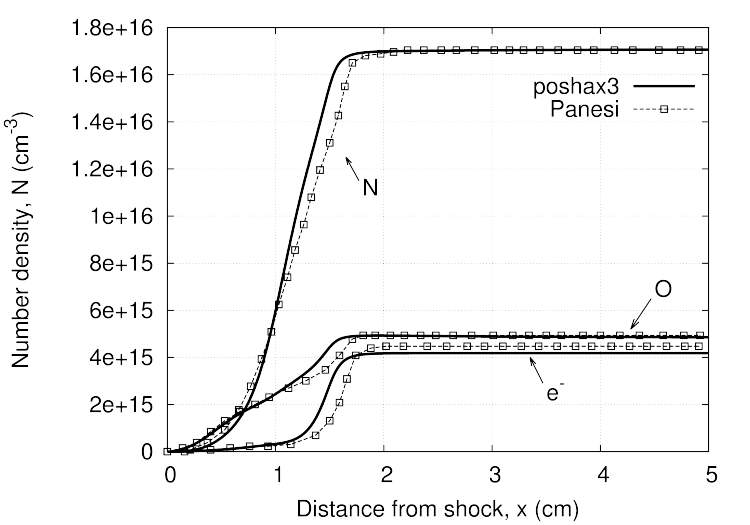Simulation of stagnation streamline on FireII vehicle¶
Description¶
This example uses Poshax3 to compute the flow immediately behind the shock at a flow condition which correspond to a flight time of 1634 s on the Fire II vehicle reentry trajectory. The details of the calculation can be found in Chapter 5 of the author’s thesis.
This example is found in the code collection at:
$CFCFD/examples/poshax3/FireII/1634s
Files¶
User-built files:
- FireII.cfg
- Input file for Poshax3.
- air-11sp-2T.inp
- Input file for describing the gas model.
- Park93-s05-PEIIC.lua
- Input file for the chemical reaction model.
- air-TV-TE.lua
- Input file for the energy exchange model.
- run.sh
- A script to execute the example and plot results.
Gas model input file:
- air-11sp-2T-HO.lua
- Gas model input file for direct use by Poshax3. This
file is created using the
gasfileprogram.
Output file:
- output.data
- Output file from Poshax3 calculation. This contains flow properties as a function of distance downstream of the shock. This file is only available after running the calculation.
Data files:
- marco_1634s_??.txt
- Number densities and temperatures as calculated in Marco Panesi’s PhD thesis.
Results files:
- profiles.gplot
- A Gnuplot input file for plotting of results.
- number_density_profiles.*
- Plot of number density profiles of key species.
- temperature_profiles.*
- Plot of temperature profiles.
Running the simulation¶
The steps to running and plotting results are contained in the script: run.sh.
This can be executed at the command line, from this working directory as:
> ./run.sh
Results¶
This example tests the ability of Poshax3 to correctly solve the post-shock relaxation problem with both thermal and chemical nonequilibrium. The output from the calculation are the flowproperties against distance behind the shock. A comparison of the temperature and number density profiles with the results obtained by Marco Panesi in his PhD thesis are shown below. The differences between the calculations can be attributed to variations in the thermodynamic modelling of key species such as N2.

